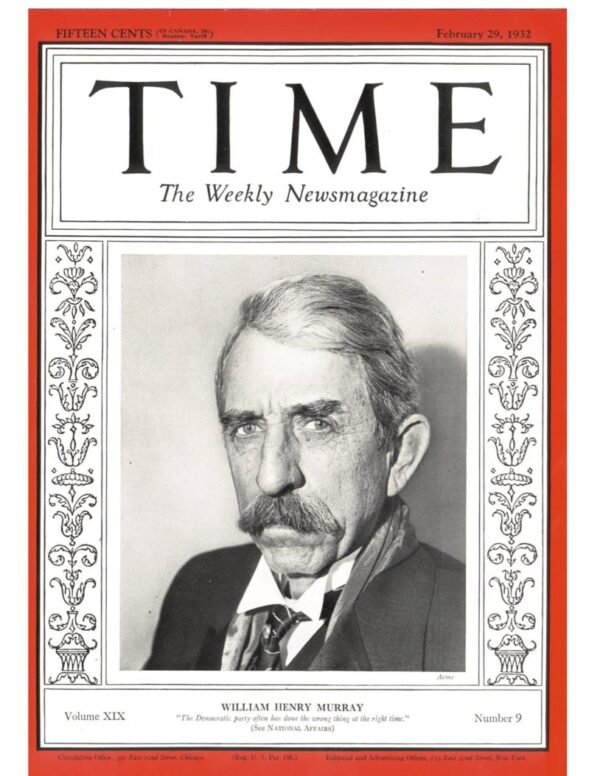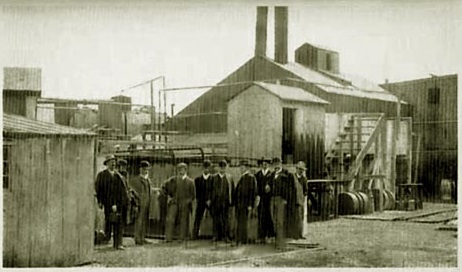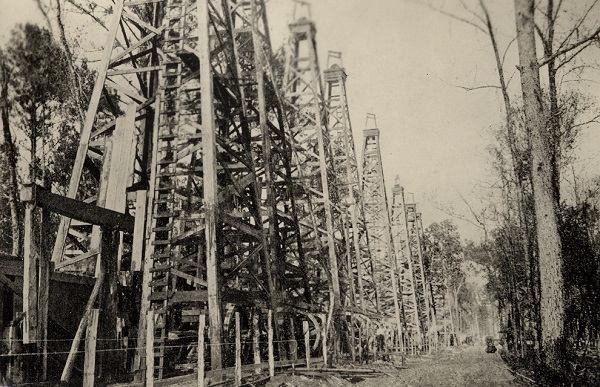This Week in Petroleum History: March 3 – 9
March 3, 1879 – United States Geological Survey established –
President Rutherford B. Hayes signed legislation creating the United States Geological Survey (USGS) within the Department of the Interior. The legislation resulted from a report by the National Academy of Sciences, which had been asked by Congress to provide a plan for surveying the country.

Original logo for the U.S. Geological Survey and the current one. The motto “science for a changing world” was added in 1997.
The new agency’s mission included “classification of the public lands, and examination of the geological structure, mineral resources, and products of the national domain,” according to USGS, which since 1974 has been headquartered on a 105-acre site in Reston, Virginia. USGS maintains the world’s largest library collection dedicated to earth and natural sciences, including more than one million books, 600,000 maps, and 500,000 photographs.
March 3, 1886 – Natural Gas brings light to Paola, Kansas
Paola became the first town in Kansas to use natural gas commercially for illumination. To promote its natural gas resources and attract businesses from nearby Kansas City, civic leaders erected four flambeaux arches in the town square. Pipes were laid for other illuminated displays.

“Pearl Street Looking South, Paola, Kansas” is among images preserved by the Miami County Kansas Historical Society & Museum. An annual Paola Roots Festival began in 1990.
“Paola was lighted with Gas,” proclaimed an exhibit at the Miami County Historical Museum. “The pipeline was completed from the Westfall farm to the square and a grand illumination was held.” By the end of 1887, several Kansas flour mills were fueled by natural gas. Paola’s gas wells would run dry, but more mid-continent oil discoveries would follow
March 4, 1918 – West Virginia Well sets World Depth Record
Hope Natural Gas Company completed an oil well at a depth of 7,386 feet on the Martha Goff farm in Harrison County, West Virginia. The cable-tool well became the world’s deepest until surpassed by a 1919 well in nearby Marion County. The previous world record had been a well in Germany at 7,345 feet.

Drilled with cable-tools near Clarksburg, this 1918 West Virginia well was the world’s deepest until one drilled in a neighboring county. Photo courtesy West Virginia Oil and Natural Gas Association.
In 1953, the New York State Natural Gas Corporation claimed the world’s deepest cable-tool well at a depth of 11,145 feet at Van Etten, New York. A rotary rig depth record was set in 1974 by the Bertha Rogers No. 1 well at 31,441 feet, and a Soviet Union experimental well in 1989 reached 40,230 feet — the current world record.
March 4, 1933 – Oklahoma City Oilfield under Martial Law
Oklahoma Governor William H. “Alfalfa Bill” Murray declared martial law to enforce his regulations strictly limiting production in the Oklahoma City oilfield, discovered in December 1928. Two years earlier, Murray had called a meeting of fellow governors from Texas, Kansas and New Mexico to create an Oil States Advisory Committee, “to study the present distressed condition of the petroleum industry.”

William “Alfalfa Bill” Murray in 1932.
Elected in 1930, the controversial politician was called “Alfalfa Bill” because of speeches urging farmers to plant alfalfa to restore nitrogen to the soil. By the end of his administration, Murray had called out the National Guard 47 times and declared martial law more than 30 times. He was succeeded as Oklahoma governor by E.W. Marland in 1935.
March 4, 1938 – Giant Oilfield discovery in Arkansas
The Kerr-Lynn Oil Company (a Kerr-McGee predecessor) completed its Barnett No. 1 well east of Magnolia, Arkansas, discovering the giant Magnolia oilfield, which would become the largest producing field (in volume) during the early years of World War II, helping to fuel the American war effort.

Crew members stand in front of their 1938 giant oilfield discovery well at Magnolia, Arkansas. Photo courtesy W.B. “Buzz” Sawyer.
The southern Arkansas gusher launched a Columbia County oil boom similar to Union County’s Busey-Armstrong No. 1 well southwest of El Dorado in January 1921 (see First Arkansas Oil Wells).
March 5, 1895 – First Wyoming Refinery produces Lubricants
Near the Chicago & North Western railroad tracks in Casper, Civil War veteran Philip “Mark” Shannon and his Pennsylvania investors opened Wyoming’s first refinery. It could produce 100 barrels a day of 15 different grades of lubricant, from “light cylinder oil” to heavy grease. Shannon and his associates incorporated as Pennsylvania Oil and Gas Company.

The original Casper oil refinery in Wyoming, circa 1895. Photo courtesy Wyoming Tales and Trails.
By 1904, Shannon’s company owned 14 wells in the Salt Creek field, about 45 miles from the company’s refinery (two days by wagon). Each well produced up to 40 barrels of oil per day, but transportation costs meant Wyoming oil could not compete for eastern markets. The state’s first petroleum boom began in 1908 with Salt Creek’s “Big Dutch” well.
Learn more in First Wyoming Oil Wells.
March 6, 1935 – Search for First Utah Oil proves Deadly
More than a decade before Utah’s first commercial oil wells, residents of St. George had hoped the “shooting” of a well drilled by Arrowhead Petroleum Company would bring black gold prosperity. A crowd had gathered to watch as workers prepared six, 10-foot-long explosive canisters to fracture the 3,200-foot-deep Escalante No. 1 well.

The Escalante well heralded new prosperity for residents of nearby St. George, Utah, in 1935 — until an attempt to shoot the well went wrong and canisters of TNT and nitroglycerin exploded. Photo courtesy Washington County Historical Society.
An explosion occurred as the torpedoes, “each loaded with nitroglycerin and TNT and hanging from the derrick,” were being lowered into the well. Ten people died from the detonations, which “sent a shaft of fire into the night that was seen as far as 18 miles away.”
The 1935 accident has remained the worst oil-related disaster in Utah, according to The Escalante Well Incident, a 2007 historical account.
March 6, 1981 — Shale Revolution begins in North Texas
Mitchell Energy and Development Corporation drilled its C.W. Slay No. 1 well, the first commercial natural gas well of the Barnett shale formation. Over the next four years, the vertical well in North Texas produced nearly a billion cubic feet of gas, but it would take almost two decades to perfect cost-effective shale fracturing methods combined with horizontal drilling.

Production from the Barnett shale formation extends from Dallas west and south, covering 5,000 square miles, according to the Texas Railroad Commission. Chart courtesy Dan Plazak.
Mitchell Energy’s 7,500-foot-deep well and others in Wise County helped evaluate seismic and fracturing data to understand deep shale structures. “The C.W. Slay No. 1 and the subsequent wells drilled into the Barnett formation laid the foundation for the shale revolution, proving that natural gas could be extracted from the dense, black rock thousands of feet underground,” the Dallas Morning News later declared.
By the end of 2012, with almost 14,000 wells drilled in the largest gas field in Texas, production started to decline, but the Barnett field still accounted for 6.1 percent of Texas natural gas production and 1.8 percent of the U.S. supply, according to the Federal Reserve Bank of Dallas.
March 7, 1902 – Oil discovered at Sour Lake, Texas
Adding to the giant oilfields of Texas, the Sour Lake field was discovered about 20 miles west of the world-famous Spindletop gusher of January 1901. The spa town of Sour Lake quickly became a boom town where major oil companies, including Texaco, got their start.

“The resort town of Sour Lake, 20 miles northwest of Beaumont, was transformed into an oil boom town when a gusher was hit in 1902,” notes the Texas State Library and Archives Commission.
Originally settled in 1835 and called Sour Lake Springs because of its “sulphureus spring water” known for healing, the sulfur wells attracted many exploration companies. Some petroleum geologists predicted a Sour Lake salt dome formation similar to that revealed by Pattillo Higgins, the Prophet of Spindletop.
Sour Lake’s 1902 discovery well was the second attempt of the Great Western Company. The well, drilled “north of the old hotel building,” penetrated 40 feet of oil sands before reaching a total depth of about 700 feet. The Hardin County’s salt dome oilfield yielded almost nine million barrels of oil by 1903, when the Texas Company made its first major oil find at Sour Lake.
Learn more in Sour Lake produces Texaco.
March 7, 2007 – National Artificial Reef Plan updated
The National Marine Fisheries Service of the National Oceanic and Atmospheric Administration (NOAA), approved a comprehensive update of the 1985 National Artificial Reef Plan, popularly known as the “rigs to reefs” program.

A typical platform provides almost three acres of feeding habitat for thousands of species. Photo courtesy U.S. Bureau of Safety and Environmental Enforcement.
The agency worked with interstate marine commissions and state artificial reef programs, “to promote and facilitate responsible and effective artificial reef use based on the best scientific information available.” The revised National Artificial Reef Plan included guidelines for converting old platforms into reefs. A typical four-leg structure provides up to three acres of habitat for hundreds of marine species.
“As of December 2021, 573 platforms previously installed on the U.S. Outer Continental Shelf have been reefed in the Gulf of Mexico,” according to the Bureau of Safety and Environmental Enforcement (BSEE).
Learn more in Rigs to Reefs.
March 9, 1930 – Prototype Oil Tanker is Electrically Welded
The world’s first electrically welded commercial vessel, the Texas Company (later Texaco) tanker M/S Carolinian, was completed in Charleston, South Carolina. The World War I shipbuilding boom encouraged new electric welding technologies. The oil company’s 226-ton vessel was a prototype designed by naval architect Richard Smith.

Construction of M/S Carolinian began in 1929. The M/S designation meant it used an internal combustion engine. Photo courtesy Z.P. Liollio.
The tanker — the first electrically welded ship — eliminated the need for about 85,000 pounds of rivets, according to a 2017 article for the International Committee for the Conservation of the Industrial Heritage (TICCIH). Success of the prototype led to “the standard of welded hulls and internal combustion engines would become universal in construction of new vessels.”
March 9, 1959 – Barbie is a Petroleum Doll
Mattel revealed the Barbie Doll at the American Toy Fair in New York City. More than one billion “dolls in the Barbie family” have been sold since. Eleven inches tall, Barbie owes her existence to petroleum products and the science of polymerization, including several plastic acronyms: ABS, EVA, PBT, and PVC.

Petroleum-based polymers are part of Barbie’s DNA.
Acrylonitrile-Butadiene-Styrene (ABS) is known for strength and flexibility. This thermoplastic polymer is used in Barbie’s torso to provide impact and heat resistance. EVA (Ethylene-Vinyl Acetate), a copolymer made up of ethylene and vinyl acetate, protects Barbie’s smooth surface.
The Mattel doll also includes Polybutylene Terephthalate (PBT), a thermoplastic polymer often used as an electrical insulator. A mineral component facilitates PBT injection molding of her “full figure,” according to the company. Barbie’s hair and many of her designer outfits are made from the world’s first synthetic fiber, nylon, invented in 1935 (see Nylon, a Petroleum Polymer and more articles in Petroleum Products).
_______________________
Recommended Reading: Trek of the Oil Finders: A History of Exploration for Petroleum (1975); History of Paola, Kansas (1956); Where it all began: The story of the people and places where the oil & gas industry began: West Virginia and southeastern Ohio
(1994); Oil And Gas In Oklahoma: Petroleum Geology In Oklahoma
(2013); Kettles and Crackers – A History of Wyoming Oil Refineries
(2016); Utah Oil Shale: Science, Technology, and Policy Perspectives
(2016); George P. Mitchell: Fracking, Sustainability, and an Unorthodox Quest to Save the Planet (2019); Sour Lake, Texas: From Mud Baths to Millionaires, 1835-1909
(1995); Rigs-to-reefs: the use of obsolete petroleum structures as artificial reefs
(1987); Plastic: The Making of a Synthetic Century Hardcover
(1996); American Fads
(1985). Your Amazon purchase benefits the American Oil & Gas Historical Society. As an Amazon Associate, AOGHS earns a commission from qualifying purchases.
_______________________
The American Oil & Gas Historical Society (AOGHS) preserves U.S. petroleum history. Please become an AOGHS annual supporter and help maintain this energy education website and expand historical research. For more information, contact bawells@aoghs.org. Copyright © 2025 Bruce A. Wells. All rights reserved.



